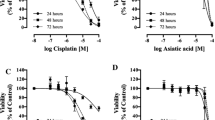Abstract
Purpose
Glioblastoma is the most aggressive malignant brain tumor. Despite multimodal treatments, median survival is only 15 months for glioblastoma patients, with tumor recurring in the resection margins after surgical removal. Hypothermia is emerging as an interesting and safe treatment for several conditions. In the context of glioblastoma, we propose that moderate hypothermia could inhibit both cell proliferation and migration, and thus help prevent secondary tumor growth.
Methods
In vitro experiments on A172, U251, U87 and T98G human glioblastoma cell lines explored the effects of severe (23 °C), moderate (28 °C), and mild (33 °C) hypothermia. We further investigated the effects of moderate hypothermia on cell proliferation, migration, morphology, and cell cycle distribution.
Results
Similar results were obtained with all four cell lines, indicating a consistent and broad effect of moderate hypothermia. Hypothermia inhibited both cell proliferation and non-oriented migration in a dose-dependent manner, with a significant reduction at 33 °C and almost total arrest at 28 °C. Cell proliferation arrest was long-lasting and oriented cell migration was also reduced at 28 °C. Moreover, moderate hypothermia significantly altered cell cycle distribution, with cells accumulating in the G2/M phase, leading to cell cycle arrest. Lastly, hypothermia at 28 °C also affected cell morphology by deteriorating cell membranes and altering cell shape.
Conclusions
The presented results demonstrate that moderate hypothermia could be a promising adjuvant therapy for glioblastoma treatment as it strongly inhibits both cell proliferation and migration. If in vivo preclinical results corroborate our findings, therapeutic hypothermia applied at the resection margins could probably delay tumor recurrence, combined with current treatments.






Similar content being viewed by others
References
Louis DN et al (2016) The 2016 world health organization classification of tumors of the central nervous system: a summary. Acta Neuropathol (Berl.) 131(6):803–820
Lemée J-M, Clavreul A, Menei P (2015) Intratumoral heterogeneity in glioblastoma: don’t forget the peritumoral brain zone. Neuro-Oncology 17(10):1322–1332
Zhang X, Ding K, Wang J, Li X, Zhao P (2019) Chemoresistance caused by the microenvironment of glioblastoma and the corresponding solutions. Biomed Pharmacother 109:39–46
Okolie O et al (2016) Reactive astrocytes potentiate tumor aggressiveness in a murine glioma resectionand recurrence model. Neuro-Oncology 18(12):1622–1633
O’Leary DP, O’Leary E, Foley N, Cotter TG, Wang JH, Redmond HP (2016) Effects of surgery on the cancer stem cell niche. Eur J Surg Oncol 42(3):319–325
Bernard SA et al (2002) Treatment of comatose survivors of out-of-hospital cardiac arrest with induced hypothermia. N Engl J Med 346(8):557–563
Hypothermia after Cardiac Arrest Study Group (2002) Mild therapeutic hypothermia to improve the neurologic outcome after cardiac arrest. N Engl J Med 346(8):549–556
Writing Group et al (2003) Therapeutic hypothermia after cardiac arrest: an advisory statement by the advanced life support task force of the international liaison committee on resuscitation. Circulation 108(1):118–121
Dietrich WD, Bramlett HM (2016) Therapeutic hypothermia and targeted temperature management in traumatic brain injury: clinical challenges for successful translation. Brain Res 1640:94–103
Kalamida D, Karagounis IV, Mitrakas A, Kalamida S, Giatromanolaki A, and Koukourakis MI (2015) Fever-range hyperthermia vs. hypothermia effect on cancer cell viability, proliferation and HSP90 expression. PLoS ONE 10(1):e0116021
Zhang H (2012) Effect of mild hypothermia on breast cancer cells adhesion and migration. Biosci Trends 6:313–324
Matijasevic Z (2002) Selective protection of non-cancer cells by hypothermia. Anticancer Res 22(6A):3267–3272
Gluckman PD et al (2005) Selective head cooling with mild systemic hypothermia after neonatal encephalopathy: multicentre randomised trial. Lancet Lond Engl 365(9460):663–670
Nielsen N et al (2013) Targeted temperature management at 33 °C versus 36 °C after cardiac arrest. N Engl J Med 369(23):2197–2206
Matijasevic Z, Snyder JE, Ludlum DB (1998) Hypothermia causes a reversible, p53-mediated cell cycle arrest in cultured fibroblasts. Oncol Res 10(11–12):605–610
Acknowledgements
This work received financial support through grants from the Groupement des Entreprises Françaises de Lutte contre le Cancer (GEFLUC Grenoble – Dauphiné – Savoie) and the Fonds de dotation Clinatec. We thank Maighread Gallagher-Gambarelli from TWS Editing for providing linguistic support and suggestions on language usage for the manuscript.
Author information
Authors and Affiliations
Corresponding authors
Ethics declarations
Conflict of interest
The authors declare that they have no conflict of interest.
Ethical approval
This article does not contain any studies with human participants or animals performed by any of the authors.
Additional information
Publisher's Note
Springer Nature remains neutral with regard to jurisdictional claims in published maps and institutional affiliations.
Rights and permissions
About this article
Cite this article
Fulbert, C., Gaude, C., Sulpice, E. et al. Moderate hypothermia inhibits both proliferation and migration of human glioblastoma cells. J Neurooncol 144, 489–499 (2019). https://doi.org/10.1007/s11060-019-03263-3
Received:
Accepted:
Published:
Issue Date:
DOI: https://doi.org/10.1007/s11060-019-03263-3




